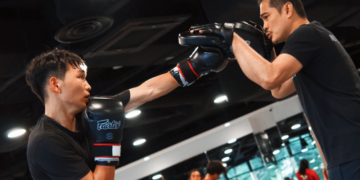
Clinching is a fundamental part of Muay Thai. Its brutal nature makes the art of eight limbs stand out from other combat sports and if you can’t clinch then you will find yourself at the mercy of a nak muay who specialises in this punishing style of fighting.
It is common in many of Thailand’s gyms to clinch for up to 45 minutes at the end of every session but in the West, it tends to be overlooked by many gyms that focus on the striking aspect of the sport. If you want to develop as a fighter, then it is important to focus on clinching almost every time you are in the gym.
If you often feel like you’re being tossed around the ring as soon as someone gets a hold of your neck, or if you’re a newcomer to the world of Muay Thai and are looking to build a strong foundation, then this article is a must-read. It provides insights into 7 essential drills designed to enhance your clinch game, allowing you to gain control and confidence in the clinch.
1) Build Your Strength
Clinching involves wrestling with your opponent to control their neck and arms in order to set up devastating knee and elbow strikes. It is an incredibly taxing way to fight and often, the stronger fighter is the one who dominates. You will need to dedicate yourself to a strength program that will develop power and endurance through your upper body. It is difficult to clinch without wearing a few knees to the guts so daily core work also needs to be a part of your routine if you don’t want to get the wind knocked out of you.
Neck strength is vitally important if you don’t want to get pulled down and kneed in the face so try adding some of these exercises to your daily regimen.
2) Practice Entering The Clinch Safely
In order to clinch in a fight, you are going to need to close the distance between you and your opponent by getting past their long-range weapons such as teeps and kicks. Once you do that you need to reach out and grab them without eating punches and getting sliced open by elbows. The best way to do this is to keep your guard tight while you look for opportunities to control your opponents’ arms when you get into range. You can do this by either slipping and parrying their punches or by using your own strikes so that their hands are too busy defending to catch you as you lock them up.
Watch how golden era legend Jaroenthong Kiatbanchong evades punches or uses arm control to enter the clinch with great effect in the video above.
3) Practice Landing Scoring Knees
In Muay Thai, a knee needs to have a clear effect to be considered a scoring shot and it is the knees down the middle that fold an opponent’s body in half that have the greatest impact on the score cards. Generally, a fighter will try and close the distance between themselves and their opponent when they are not in a dominant position so that a big knee can’t land. You will need to practice turning your opponent off balance by pivoting your feet and pulling on their head to create space for a massive scoring knee. Check out the above demonstration by multiple-time Muay Thai World Champion Sagetdao Petpayathai on how to effectively deliver swing knees.
4) Learn The Basic Clinch Positions
There are a number of clinch positions that are common in Muay Thai, whether it is top-lock, body-lock or the 50/50 position you will need to learn each one by heart.
Here are a few positions that you should practice until they become second nature.
5) Learn To Control The Arms
The clinch doesn’t just allow for you to land knees. Successfully controlling your opponents’ arms provides great opportunities for you to land elbows and mastering this aspect of your clinch game will allow you to stop your opponent from landing their own.
Here is a quick tutorial on arm control that you should practice. Notice on how the emphasis is placed on keeping the arms on the dominant inside position where it is easiest to land elbows and move into strong locks.
6) Drill Your Sweeps
There is nothing more dominant than throwing your opponent to the canvas and it scores highly in the eyes of the judges. If you are having huge success in the clinch, it is sometimes better to maintain a strong lock rather than sweeping your opponent because then it gives them the chance to score at range. That being said, if you are looking for a huge score to finish a round in a big way then you should drill, drill and drill a few of these essential sweeps.
7) Learn When To ‘Shut Down’ The Clinch
A referee will break the clinch if it becomes inactive and neither fighter is landing scoring knees or elbows. If your opponent is getting the upper hand in the clinch and you find yourself unable to land scoring shots of your own, sometimes it is better to stall or disengage. This will force a separation where you can then choose to re-enter the clinch or keep your distance to score at range.
Pushing the biceps from an inside position, body-locking your opponent on the ropes where there isn’t space for them to knee, or the classic knee guard are all great strategies for shutting down the clinch.
In this video, Muay Thai World Champion Chaowalit Jocky Gym demonstrates the knee guard, a great technique you can use to stop your opponent from landing knees.
Conclusion
The clinch is an essential part of Muay Thai and if you don’t know the basics then you can’t call yourself a true Thai Boxer. The inclusion of these 7 drills in your training routine will help you develop the skills necessary to successfully engage in a Muay Khao battle but remember, the best way to improve your clinching is regular, consistent clinch sparring. The best Thai fighters in the world clinch after every session and if you want to successfully beat them, then you should too.
You may also like:
11 Important Muay Thai Sparring Etiquette You Need To Know
9 Pro Tips For Muay Thai Shin Conditioning
Punching is an integral part of any combat sport, whether it’s Boxing, Kickboxing, Muay Thai, or MMA. The ability to land powerful punches is essential for any combat athlete. Even if you are primarily a…
In the world of Muay Thai, counter fighters are revered for their exceptional defensive prowess and impeccable timing. Some of these skilled practitioners possess the ability to exploit their opponent’s mistakes and capitalize on openings…
The elbow strike is a brutal short-range weapon used in Muay Thai. The force and damage that can be inflicted can be devastating and the results can quickly end a fight. Elbow strikes pack a…
In Muay Thai, fighters look for ways to enhance their defensive capabilities and maintain control over their opponents. One such technique that has gained significant recognition is the knee guard. The knee guard is a…
In the world of Muay Thai, developing fluid and effective striking combinations is crucial for success. It’s not only about rehearsing and throwing the same combos over and over, you will need to develop over…
In the world of Muay Thai, where fighters aim to achieve maximum efficiency and strategic advantage, being a southpaw can provide a unique edge. Standing with their right foot forward and left foot back, opposite…
In Brazilian Jiu-Jitsu, the common route towards pinning the opponent is first getting past their legs. This means that you have to pass their guard to get to their upper body. A successful guard pass…
Boxing is one of the most globalized combat sports, and the top boxers remain some of the highest-paid athletes in the world. Anyone can master the sweet science and enjoy the many rewards that come…
Whether you’re seeking a new way to stay fit, a method for enhancing personal discipline, or a reliable means of self-protection, martial arts can be a rewarding and practical pursuit. However, navigating the martial arts…
One of the best ways to finish an opponent in BJJ is to get behind and choke them. Getting behind an opponent gives you a solid advantage as it allows you to set up different…
The question of when to eat before martial arts training has long been debated. Some believe competitors should abstain from food for five hours or more, while others consider a more liberal approach to be…
Brazilian Jiu-Jitsu is a grappling sport that favors fighting on multiple planes of combat. You can engage from the standing position, similar to how they do in Judo, or you can grapple with your back…




































